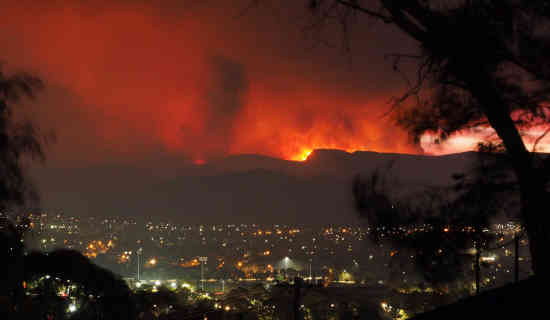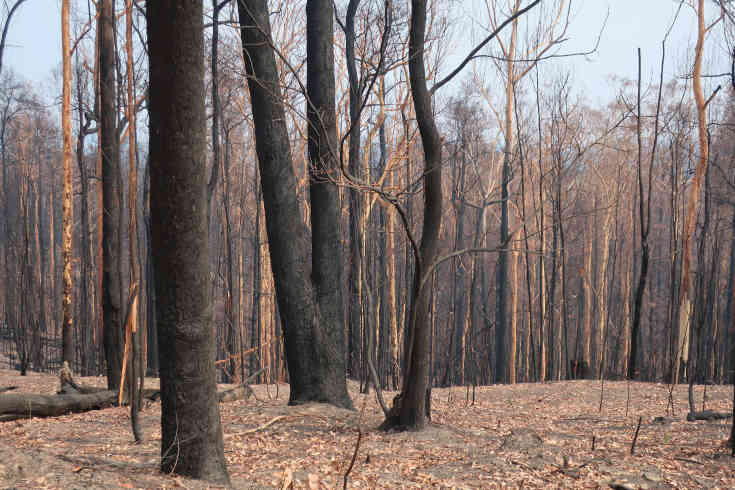Claim
Bjorn Lomborg claimed that climate change is not making bushfires in Australia worse. In fact, he says, fires are not as bad as they once were.
With two bushfire enquiries currently underway, it is timely to check this out.
Background
Bjorn Lomborg is a public commentator on climate change who accepts that the climate is changing and we shouldn’t ignore it. But he argues that:
- its seriousness is overstated,
- it would cost too much to try to reduce it,
- we wouldn’t succeed anyway, and
- we can manage the problems it causes if we are smart.
Earlier this year, in an interview with former Deputy Prime Minister John Anderson posted on Facebook, Lomborg argued that climate change is not affecting bushfires significantly because the total area of Australia burnt has more than halved in the past century.
Is this true?
Assessment
It turns out that the facts Bjorn quotes are true. The graph shown on the video shows a drop in area burnt from about 11% of Australia per decade in 1900 to 5% per decade in 2020.
But the conclusion he draws is not true. Let’s see why.
How to assess the seriousness of bushfires?
There are many ways to measure the seriousness of bushfires, and area burnt (which Lomborg uses) is just one of them. Other important factors are:
- lives lost,
- damage caused,
- species lost,
- the value and type of land burnt, and
- the severity and ferocity of the fires.
Lomborg briefly alludes to some of these factors but doesn’t give any details.
The earlier fires which burnt larger areas were generally in remote or grassland areas where the losses of lives, property, animals and vegetation were not nearly as severe as occurred this year, and the land recovers quickly.
For example, the 117 million hectares burnt in 1974/75 were in grasslands in central Australia and their impact on the landscape was actually quite small, although significant damage was done and 6 lives lost.
The recent fires were much more significant – read on to see why.
Causes and types of fires
In the video, Bjorn didn’t mention the cause of the fires, but this is important. Globally, the occurrence of rural fires is decreasing, but that doesn’t mean climate change isn’t having an effect. For fires deliberately lit for land clearing are reducing, whereas fires caused by climate change are actually increasing.
Fire was once used by white settlers in Australia as a means of clearing land, and sometimes these fires got out of control. And of course these fires are much less common these days, but could be severe back in the day.
An example is the disastrous Victoria 1938/39 bushfires, where “only” 2 million hectares burnt in Victoria, but 71 lives lost and there was much damage to towns and rural activities. The Stretton Royal Commission into found that “most of the fires were lit by the ‘hand of man’”.
So it wasn’t the climate that caused those fires, though a long drought made fire conditions worse. It was deliberate burning.
The Commission also found that many of the fires were allowed to burn, so management of the fires is another factor in their extent.
Since that time, very little land is cleared by fire, and fire management and firefighting has improved significantly. So you’d expect there to be fewer, if any at all, of those fires.
Thus it is inaccurate to draw the conclusion that climate change isn’t having an effect on fires. The two causes have to be separated out, which Bjorn Lomborg didn’t do.

The disastrous effect of climate change
Most important of all, we must consider how climate change has affected fires in their totality, not just the area burnt. And fire-fighters and scientists all agree that these recent fires were “unprecedented” for many reasons:
- The fire season was far longer, starting in August, and making it impossible to carry out the hazard reduction burning planned. The change in the fire season is a direct result (and a prediction) of climate change.
- The fuel was drier than normal because of the long drought, another result of climate change.
- The weather was unprecedented, hotter, drier and with dry lightning. The fires were so severe they created their own weather (another unprecedented result of climate change).
- Much larger areas of forest were burnt than has happened before. Associate Professor Owen Price from the University of Wollongong says: “The biggest fire seasons in the past have burnt about 20% of the forest. But this time it is going to be more than half, which puts animals at a much higher risk.”
- Some of the fires burned in “permanently wet” forests that have never burnt before in human history – truly unprecedented.
- The damage to Australia’s wildlife has been enormous, with ecologically important forests badly burnt (some may never recover). At least a billion birds, mammals and reptiles have been killed (not to mention smaller animals and insects). Some species of plants and animals may have been driven to extinction. This is truly unprecedented!
All this occurred at a time when fire management and technology is at its most sophisticated, and despite the untiring efforts of thousands of fire-fighters.
Computer models confirm this
Computer studies of a series of fires in 2018 compared the results in a world with current greenhouse-gas concentrations versus one with pre-industrial levels. It found that extreme temperatures were now 4.5 times more likely, and lower rainfall was also more likely.
Conclusion
The 2020 Australian fires were unprecedented. They were worse than previous fires in many very important ways, even though they did not burn the largest area.
And they were made much worse by climate change.
Climate change is making our fire risk greater and the fires more severe. This trend will continue unless we make changes in carbon emissions.
The verdict
Bjorn Lomborg’s claim about the effect of climate change is misleading, it isn’t based on all the evidence, and so cannot be accepted.
We shouldn’t trust anyone who simplifies things down to one fact and ignores the many other facts that are more important in answering the question.
In the end, we should know that the fire-fighters and the scientists know more than Bjorn Lomborg, who is, after all, a political scientist.
Bob Ward (policy and communications director of the Grantham Research Institute on Climate Change and the Environment and the ESRC Centre for Climate Change Economics and Policy at the London School of Economics and Political Science), reviewed Lomborg’s misinformation about climate change, and said:
“Dr Lomborg now has a long track record of being an unreliable and inaccurate source of information about climate change. He devotes most of his writing efforts to churning out polemics for the opinion columns of newspapers which fail to fact-check his false claims.”
References
Unpacking the National Bushfire and Climate Summit 2020. Climate Council.
The race to decipher how climate change influenced Australia’s record fires. Nature, January 2020.
Main photo: burnt bushland in the North Brooman State Forest after the Currowan fire, 2020. (Eric Hatfield)
